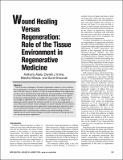| dc.contributor.author | Atala, Anthony | |
| dc.contributor.author | Irvine, Darrell J. | |
| dc.contributor.author | Moses, Marsha A. | |
| dc.contributor.author | Shaunak, Sunil | |
| dc.date.accessioned | 2013-07-26T16:23:07Z | |
| dc.date.available | 2013-07-26T16:23:07Z | |
| dc.date.issued | 2010-08 | |
| dc.identifier.issn | 0883-7694 | |
| dc.identifier.issn | 1938-1425 | |
| dc.identifier.uri | http://hdl.handle.net/1721.1/79711 | |
| dc.description.abstract | One of the major challenges in the field of regenerative medicine is how to optimize tissue regeneration in the body by therapeutically manipulating its natural ability to form scar at the time of injury or disease. It is often the balance between tissue regeneration, a process that is activated at the onset of disease, and scar formation, which develops as a result of the disease process that determines the ability of the tissue or organ to be functional. Using biomaterials as scaffolds often can provide a “bridge” for normal tissue edges to regenerate over small distances, usually up to 1 cm. Larger tissue defect gaps typically require both scaffolds and cells for normal tissue regeneration to occur without scar formation. Various strategies can help to modulate the scar response and can potentially enhance tissue regeneration. Understanding the mechanistic basis of such multivariate interactions as the scar microenvironment, the immune system, extracellular matrix, and inflammatory cytokines may enable the design of tissue engineering and wound healing strategies that directly modulate the healing response in a manner favorable to regeneration. | en_US |
| dc.description.sponsorship | Howard Hughes Medical Institute (Irvine, Darrell J.) | en_US |
| dc.language.iso | en_US | |
| dc.publisher | Cambridge University Press (Materials Research Society) | en_US |
| dc.relation.isversionof | http://dx.doi.org/10.1557/mrs2010.528 | en_US |
| dc.rights | Article is made available in accordance with the publisher's policy and may be subject to US copyright law. Please refer to the publisher's site for terms of use. | en_US |
| dc.source | MIT web domain | en_US |
| dc.title | Wound Healing Versus Regeneration: Role of the Tissue Environment in Regenerative Medicine | en_US |
| dc.type | Article | en_US |
| dc.identifier.citation | Atala, Anthony, Darrell J. Irvine, Marsha Moses, and Sunil Shaunak. “Wound Healing Versus Regeneration: Role of the Tissue Environment in Regenerative Medicine.” MRS Bulletin 35, no. 08 (August 31, 2010): 597-606. © Materials Research Society 2010 | en_US |
| dc.contributor.department | Massachusetts Institute of Technology. Department of Materials Science and Engineering | en_US |
| dc.contributor.mitauthor | Irvine, Darrell J. | en_US |
| dc.relation.journal | MRS Bulletin | en_US |
| dc.eprint.version | Final published version | en_US |
| dc.type.uri | http://purl.org/eprint/type/JournalArticle | en_US |
| eprint.status | http://purl.org/eprint/status/PeerReviewed | en_US |
| dspace.orderedauthors | Atala, Anthony; Irvine, Darrell J.; Moses, Marsha; Shaunak, Sunil | en_US |
| mit.license | PUBLISHER_POLICY | en_US |
| mit.metadata.status | Complete | |
